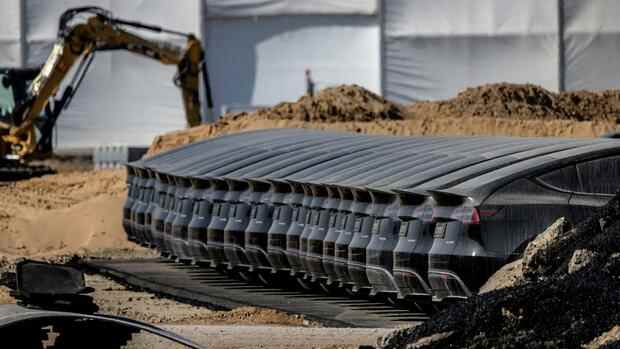Dusseldorf Economic history will be written in Brandenburg on Tuesday. The first plant of the electric mobility pioneer Tesla in Europe is opened at the Grünheide site, not far from Berlin. With the “Gigafactory”, a new automotive location is being built in the east of Germany after two years of construction and countless approval processes.
Reason enough that not only Tesla boss Elon Musk travels to the Brandenburg province. On Monday afternoon, the richest person in the world landed in his private jet in Berlin-Schoenefeld, coming directly from Texas. Tomorrow in Grünheide, the entrepreneur will meet Federal Chancellor Olaf Scholz, Federal Economics Minister Robert Habeck, Brandenburg’s Prime Minister Dietmar Woidke and his Economics Minister Jörg Steinbach.
But why the concentrated celebrity? What exactly was created here east of Berlin? Which vehicles does Tesla build there, how many people find work? And what does the Ukraine war mean for the plant and its production? The answers to the most important questions about the opening of Tesla’s Gigafactory.
What is being built in Grünheide?
For starters, it’s just the Model Y, which is half SUV and half sedan. The Model 3 could come later, the sedan will be built on the same platform. The Model Y is the latest model from Tesla, which went into production two years ago. The demand is high, the waiting time can be up to ten months depending on the equipment.
Top jobs of the day
Find the best jobs now and
be notified by email.
So far, Tesla has produced the vehicle in China and California, now Germany is joining it. A milestone for the company, but soon the series will also be produced in Texas.
>>Read also: Brandenburg’s Prime Minister sees the Tesla settlement as a signal for other investors
On Tuesday, 30 customers will receive their Model Y Performance in Grünheide. At 67,000 euros, the vehicle is the most expensive model variant. It does this in 3.7 seconds from zero to 100 km/h, the Model Y Long-Range takes five seconds.
The fact that Tesla builds vehicles with higher quality features first makes business sense. The provider can afford it, the demand is high.
The waiting time is correspondingly longer for customers who do not want more powerful engines or other extras. For Tesla, this leaves a higher margin.
When does the factory run at full speed?
The delivery of the first vehicles is more of a symbolic act. Grünheide is not yet ready to build 500,000 vehicles a year.
According to experts, Tesla needs at least three months to ramp up production to this level. Machines have to be adjusted, employees trained and delivery parts optimized.
It is an advantage for Tesla that it already produces the Model Y and knows the processes. However, the company in Grünheide wants to try out new production methods in order to achieve a higher degree of automation. This can cause problems at first.
If the teething troubles are eliminated, Grünheide will achieve a high output for the industry: one vehicle every 45 seconds. For German manufacturers, this interval is currently 60 to 70 seconds.
How many jobs will be created?
Initially there was talk of 12,000, now it will probably be 7,000. According to estimates by IG Metall, 2,500 people are currently working in Grünheide, 400 were placed by the Frankfurt (Oder) employment agency – 250 of whom were previously unemployed.
>> Read also: Tesla storms to the top VW is falling behind – the ten most popular electric cars in 2022
The fact that Tesla has only employed 2,500 people so far suggests that only one production line will be set up to begin with – because industry experts estimate that this is how many workers are needed to produce 200,000 to 250,000 vehicles.
If the first line runs smoothly, it will be mirrored. Setting up two lines that are independent of each other makes economic sense and corresponds to the usual procedure in the industry.
To employ 7,000 people, Tesla also needs to build a battery cell factory. The building for the production is currently under construction. Initially, the batteries and battery cells are delivered, but with the expected high production volume, this will later become too expensive.
Can the Ukraine war be a problem for Grünheide?
It cannot be ruled out, but it is unlikely. “Tesla & Space X are currently seeing significant price increases in raw materials and logistics,” Musk wrote on Twitter a week ago.
One reason for this is the delivery difficulties due to the Ukraine war and the sanctions against Russia. According to the stock exchange broadcaster CNBC, Tesla is said to have used aluminum from the Russian group Rusal in Grünheide. However, Norsk Hydro from Norway is the main supplier.
The price increases and the loss of Russian suppliers of nickel are worrying electric car manufacturers, the metal is mainly used for batteries. However, in recent years Tesla has been proactive in entering into supply agreements with several manufacturers such as the Australian giant BHP or smaller suppliers such as Talon Metals in the USA.
Compared to other manufacturers, Tesla manufactures many parts itself, so overall it is less dependent on suppliers. This also applies to semiconductors and other high-tech components. But the raw materials crisis is not going unnoticed by the company either: a few days ago it increased its prices by up to ten percent.
More: Tesla builds cars in the factory of the future in a fundamentally different way – German companies make it possible
